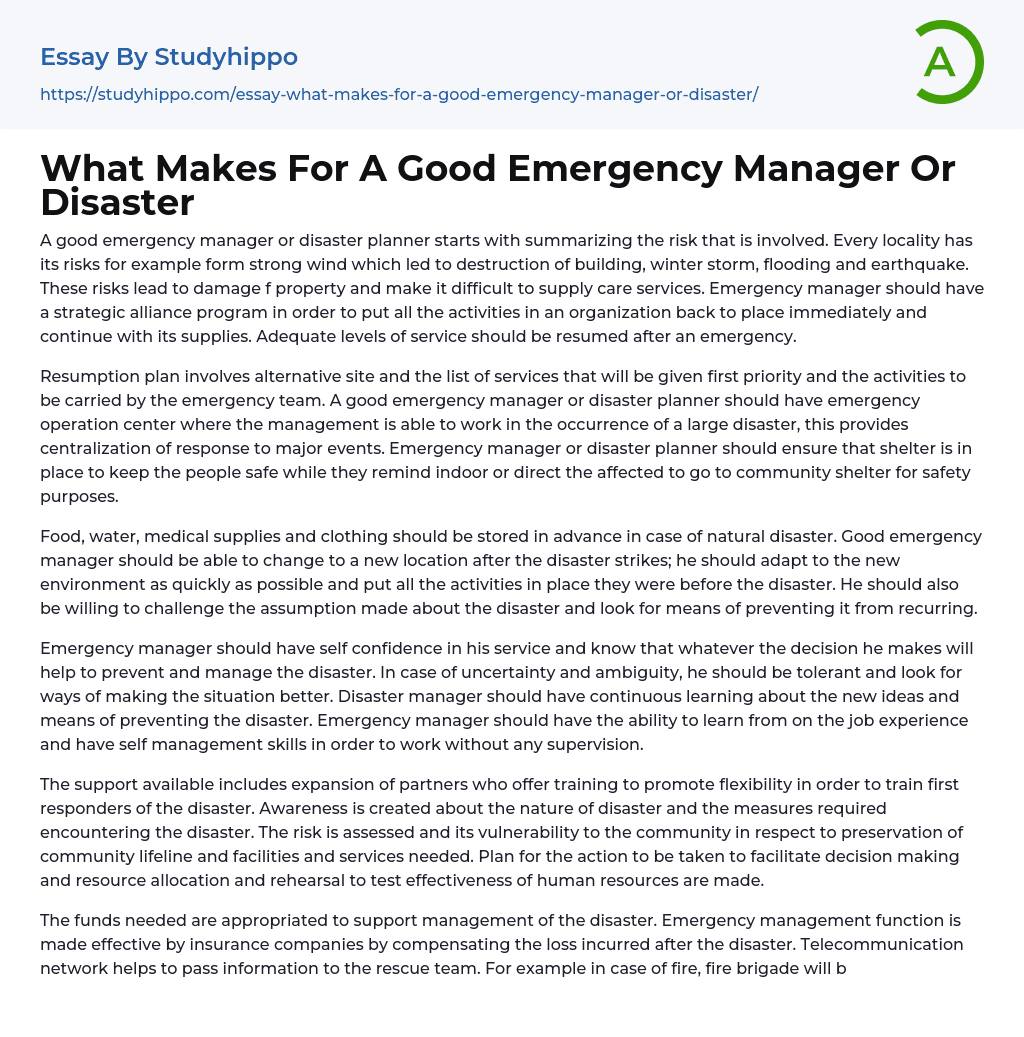

What Makes For A Good Emergency Manager Or Disaster Essay Example
An effective disaster planner or crisis manager initiates their task by pinpointing possible hazards. Each region has its distinct risks, such as powerful winds resulting in structural destruction, snowstorms, floods, and earthquakes. These perils can result in property damage and challenges in delivering care services. A strategic alliance program is vital for a crisis manager to swiftly restore organization operations and uphold supply distribution following such emergencies. It's crucial to reinstate appropriate service levels post-disaster.
The action plan for resuming operations includes determining an alternate location along with identifying priority services and tasks to be overseen by the emergency team. For effective response in the event of a significant catastrophe, a proficient emergency manager or disaster planner must have an emergency operations center. This center allows for central coordination of significant event responses. Moreover,
...it is crucial for the emergency manager or disaster planner to ensure adequate shelter arrangements. These may be used to secure individuals indoors or guide the affected people towards community shelters for their safety.
Necessities such as food, water, apparel, and healthcare provisions ought to be prepared in advance for a potential natural calamity. A proficient crisis manager should possess the capacity to rapidly evacuate post-disaster, adjust promptly to different circumstances and reestablish pre-crisis normalcy. They also need to question prevailing beliefs about the disaster while actively developing strategies to deter its possible repetition.
A crisis manager needs to exhibit assurance and comprehend the importance of every choice pertaining to disaster minimization and handling. Regardless of any doubts or vagueness, perseverance is crucial in seeking improved conditions. Staying updated with fresh concepts and strategies for avertin
calamities is equally significant. It's imperative that these managers acquire wisdom from hands-on experiences and possess self-regulation abilities, allowing them to function independently.
The provided support encompasses the broadening of partners that present training to bolster adaptability, aiming to educate first responders for disaster situations. Active efforts are made to raise awareness about the characteristics of disasters and the necessary steps to manage them. The community's risk and vulnerability are evaluated in relation to the safeguarding of community lifelines, essential facilities, and services. Furthermore, strategies for action implementation, decision-making facilitation, resource distribution, and effectiveness testing of human resources through rehearsals are devised.
Allocated resources contribute to the effective disaster management, with insurance companies aiding significantly by covering the losses post-disaster. The telecommunication network plays a crucial role in transmitting information to the emergency response teams. For instance, in a fire situation, the fire brigade is alerted and instructed about the specific location of the incident, enabling swift action. Advancements in infrastructure, like efficient road networks, ensure all areas are promptly reachable if a disaster occurs, facilitating immediate interference at the onset of the crisis.
The community is encouraged to grow trees acting as windbreaks to protect structures and assets from the destructive force of extreme winds. Building gabions in water collection areas is vital to prevent potential flood and soil erosion risks. These constructions must be sturdy enough to resist earthquakes, thereby improving damage resistance. If there's a perceived threat of disaster in the community, it’s important that emergency coordinators are quickly notified so they can take appropriate preventative measures in advance (Meyers).
Emergency management as a field is relatively new,
evolving from prior emergency services and civil defence functions. These early roles faced obstacles in their development and lacked precise delineation. Specialists in this area have a profound understanding of the threats to economic stability and populous areas. They are acutely conscious of its impact, magnitude, potential outcomes, repetitive threat nature, and appropriate actions taken by governmental organizations. Contemporary practitioners in emergency management have honed their technical abilities to improve immediate reactions to emergencies while proactively planning for prospective future situations.
Advancements in administrative choices now emphasize proactive disaster prevention strategies such as constructing dams in flood-prone regions, instead of merely preparing for, reacting to and recovering from disasters. Furthermore, educational institutions like schools, universities and colleges are imparting emergency management skills and awarding degrees and certificates upon course completion. This development is a component of a wider operational context specifically associated with policy formulation and stakeholder support for the respective communities catered.
- Anatomy and Physiology essays
- Addiction essays
- Biodegradation essays
- Dental Care essays
- Disease essays
- Disorders essays
- Health Care essays
- Intelligence Quotient essays
- Nutrition essays
- Olfaction essays
- Public Health essays
- Women's Health essays
- World health organization essays
- Cancer essays
- Infectious Disease essays
- Lung Cancer essays
- Neurology essays
- Physical Exercise essays
- Medicine essays
- Sex essays
- Inquiry essays
- Disability essays
- Poison essays
- Action Potential essays
- Nervous System essays
- Childbirth essays
- Puberty essays
- Blood essays
- Kidney essays
- Neuron essays
- Body essays
- Glucose essays
- Sense essays
- Heart essays
- Skeleton essays
- Human Physiology essays
- Eye essays
- Immune System essays
- Muscle essays
- Skin essays
- Brain essays
- Central Nervous System essays
- Human Skin Color essays
- Digestive System essays
- Common sense essays
- Respiration essays
- alcoholism essays
- Smoking essays
- Casino essays
- Tobacco essays



